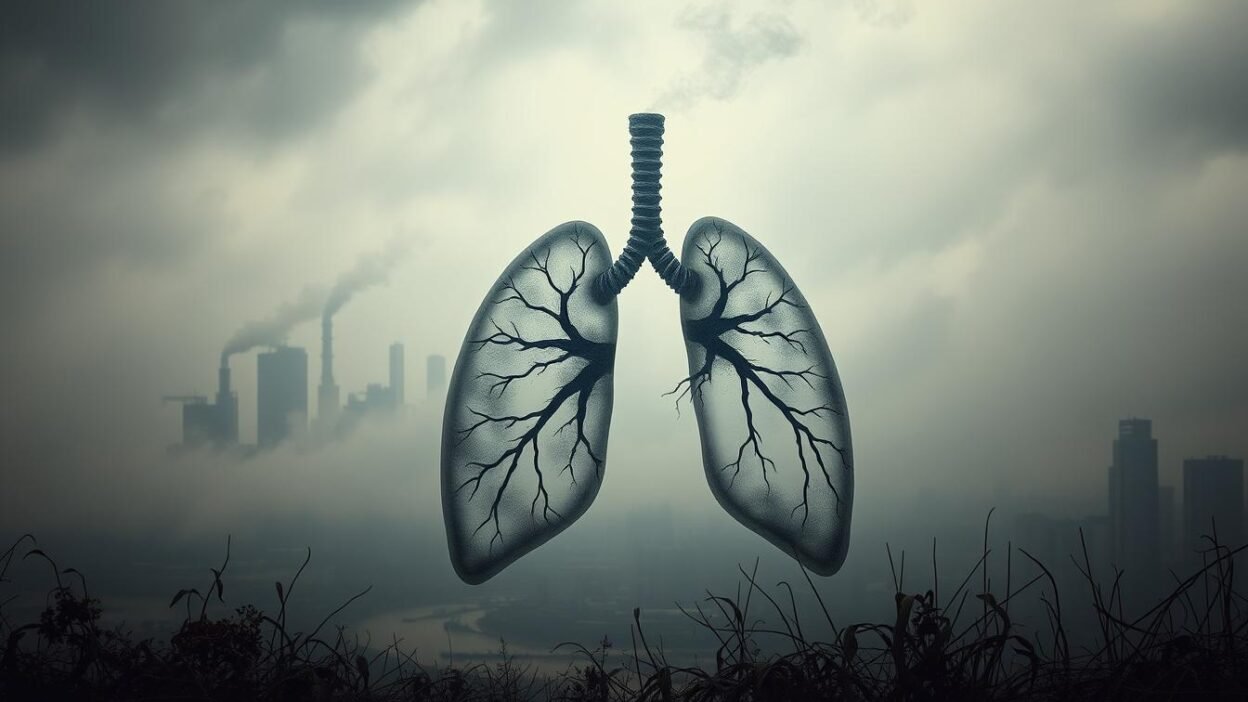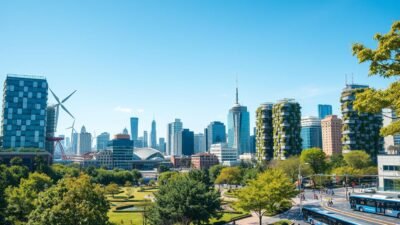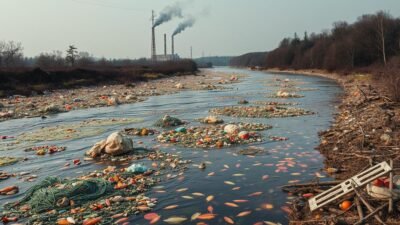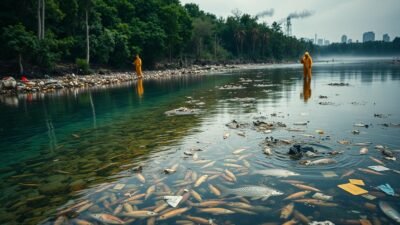Did you know air pollution kills more people than smoking, HIV/AIDS, and car accidents combined? In 2019, it took 7 million lives worldwide. It’s the top environmental cause of illness and early death, threatening our health and climate.
Impact of Air Pollution on Health
The World Health Organization (WHO) says air pollution outside is responsible for 4.2 million deaths each year. Indoor pollution adds another 3.8 million deaths. These numbers show we must act fast to fight this major health threat.
Air pollution’s effects go beyond just breathing problems. Tiny particles, or PM2.5, cause 4.5 million deaths a year from heart and lung diseases. These tiny particles can get deep into our lungs and blood, leading to serious health issues like stroke and lung cancer.
We’ll look closer at how air pollution and climate change are connected. We’ll also see who’s most at risk and what we can do to stop this global health crisis. Knowing how air pollution affects us is key to finding ways to keep us and our planet safe.
Preparing for the UGC NET exam can be a daunting task, but with the right resources, candidates can navigate the process effectively. Websites like MyJRF provide a comprehensive platform for aspiring educators, offering specialized guidance for UGC NET Paper 2 preparation and essential tips for acing UGC NET Paper 1. Additionally, understanding the revised syllabus provided by UGC is crucial for a targeted study approach. For official announcements and updates, candidates should regularly visit the UGC NET NTA portal, while the UGC’s job section and the main UGC website are invaluable for post-exam opportunities and academic resources. With these tools, candidates can maximize their preparation and set themselves up for success.
Key Takeaways
- Air pollution causes 7 million deaths worldwide annually
- Ambient air pollution accounts for 4.2 million deaths globally each year
- Indoor air pollution contributes to 3.8 million deaths annually
- PM2.5 is linked to 4.5 million early deaths due to cardiovascular and respiratory diseases
- Air pollution affects both human health and climate change
- Vulnerable populations include children, the elderly, and pregnant women
- Understanding air pollution’s impact is key to finding solutions
Understanding Air Pollution: A Global Health Crisis
Air pollution is a major threat to health worldwide. It harms air quality and leads to many respiratory diseases. This issue affects billions, causing serious health problems and economic losses.
Definition and Types of Air Pollutants
Air pollutants include tiny particles, ozone, nitrogen dioxide, and sulfur dioxide. They come from industrial emissions, car exhaust, and burning fossil fuels.
Current Global Statistics and Mortality Rates
The health effects of air pollution are huge:
- Over 8 million people die each year from air pollution
- 90% of these deaths happen in poorer countries
- Air pollution is the second biggest killer after smoking
Economic Impact of Air Pollution
The economic damage from air pollution is also huge:
| Aspect | Impact |
|---|---|
| Projected annual welfare costs by 2060 | $18-25 trillion |
| Official development funding for air quality projects | Less than 1% |
| Philanthropic foundation funding for air quality initiatives | Less than 0.1% |
These numbers show we need to act fast to fight air pollution. We must improve air quality to save lives and prevent respiratory diseases.
Impact of Air Pollution on Health
Air pollution is a big threat to human health, affecting millions. It harms many body systems, causing health problems.
Respiratory System Effects
Being exposed to air pollutants can lead to serious respiratory illnesses. Fine particles, like PM2.5, go deep into the lungs. This causes irritation and inflammation.
Cardiovascular Complications
Air pollution also harms the heart and blood vessels. Studies link particle pollution to more heart attacks and strokes. Long-term exposure to PM2.5 raises the risk of death by 6-8% for every 10µg/m³ increase.
Vulnerable Populations
Some groups are more at risk from air pollution. Children, older adults, and those with health issues are more vulnerable. Pregnant women exposed to long-term particle pollution face higher risks of preterm birth and low birth weight.
| Population Group | Health Risks |
|---|---|
| Children | Impaired neurological development, increased respiratory illnesses |
| Elderly | Higher mortality rates, increased cardiovascular complications |
| Pregnant Individuals | Preterm birth, low birth weight, increased fetal mortality |
Public health policies to lower air pollution can greatly help. By reducing PM2.5 levels, we can improve children’s respiratory health. This can also lower adult mortality rates, tackling a major global health issue.
Common Air Pollutants and Their Sources
Air pollution is a big threat to our health and the environment. Knowing the types and sources of pollutants is key to controlling emissions and fighting climate change. Let’s look at the most common air pollutants and where they come from.
Smog and Soot Formation
Smog is a hazy sky seen in cities. It forms when emissions from burning fossil fuels mix with sunlight. This creates ground-level ozone, a major air pollutant. Soot, tiny particles from chemicals, soil, smoke, and dust, also pollutes the air.
Hazardous Air Pollutants (HAPs)
HAPs include toxic substances like mercury, lead, and benzene. They come from industrial processes and vehicle emissions. Being exposed to HAPs can cause serious health problems, making controlling them a top priority.
Greenhouse Gases
Greenhouse gases have a big impact on pollution and climate change. They affect air quality and contribute to global warming. The most common greenhouse gas is carbon dioxide from burning fossil fuels. Methane from farming and waste also plays a big role in pollution and warming.
| Pollutant | Main Sources | Health Effects |
|---|---|---|
| Particulate Matter (PM2.5) | Vehicle emissions, industrial processes | Respiratory diseases, cardiovascular problems |
| Nitrogen Dioxide (NO2) | Combustion processes, traffic | Increased stroke risk, respiratory issues |
| Sulfur Dioxide (SO2) | Coal and oil burning | Respiratory diseases, acid rain formation |
To tackle these pollutants, we need strong emission control plans and a focus on climate change. By knowing where they come from, we can work towards cleaner air and a healthier planet.
Climate Change and Air Quality Connection
The connection between climate change and air quality is clear. As the world gets warmer, we face more health risks. It’s important to understand this link to fight climate change and adopt green practices.
Air pollution, like PM2.5 particles, causes about 6.4 million deaths worldwide each year. Most of these deaths happen in poor countries. The cost to health is huge, with air pollution damage costing $8.1 trillion a year – that’s 6.1% of global GDP.
Climate change makes air quality worse. Warmer temperatures lead to more ozone and wildfires, harming our air. This creates a vicious cycle: bad air quality makes the planet warmer, which makes air pollution worse.
To tackle these problems, we need a complete plan. Cutting down on air pollution can also help fight climate change. For example, in China’s Hebei region, cutting PM2.5 by 40% also cut CO2 emissions by 5 million tons a year.
| Region | PM2.5 Reduction | CO2 Equivalent Reduction |
|---|---|---|
| Hebei, China | 40% | 5 million tons/year |
By working on both air quality and climate change, we can improve health and reduce poverty. This approach is vital for a healthier, stronger future for everyone.
Health Impacts of Short-lived Climate Pollutants
Short-lived climate pollutants (SLCPs) are a big worry for public health and the environment. They warm our climate quickly, making them key targets for living sustainably.
Black Carbon Effects
Black carbon is a big player in global warming, after CO2. It traps sunlight, warming the air and speeding up ice and snow melt. This pollutant harms our health, causing serious breathing problems, mainly in cities.
Methane and Ozone Formation
Methane is another SLCP, with a warming effect 84 times that of CO2. It helps create ground-level ozone, a harmful air pollutant. Ozone can cause breathing and heart problems, showing we need to control pollution tightly.
Impact on Food Security
SLCPs harm food security by affecting crops and changing weather. Ozone, made from methane, cuts down on farm productivity. This shows why we must live sustainably and tackle air quality and climate change issues.
| SLCP | Global Warming Potentia | Health Impact | Environmental Effect |
|---|---|---|---|
| Black Carbon | High | Respiratory issues | Ice melt acceleration |
| Methane | 84 times CO2 | Indirect (via ozone) | Weather pattern changes |
| Ozone | Moderate | Respiratory, cardiovascular | Crop yield reduction |
Environmental Justice and Air Pollution
Environmental justice is key when it comes to air pollution. Poor air quality doesn’t affect everyone equally. Low-income communities and people of color often face more pollution and health risks.
Almost 90% of city dwellers worldwide deal with air pollution. In the U.S., people of color are 1.5 times more likely to live in polluted areas than whites. This shows we need specific health policies to fix these issues.
The health problems caused by unequal pollution are serious. Areas with lots of pollution see more asthma, heart disease, and strokes. Kids in these places get sick more often and miss school because of it.
| Population Group | Air Pollution Impact |
|---|---|
| Low-income communities | Higher exposure to pollutants |
| People of color | 1.5 times more likely to live in poor air quality areas |
| Children in urban areas | Increased asthma rates and school absences |
| Elderly | Greater risk of cardiovascular complications |
To tackle these issues, we need a variety of solutions. We should use green urban planning, better public transport, and stricter emissions rules. Also, we should invest in green spaces and clean energy to make environments healthier for everyone.
Monitoring and Measuring Air Quality
Air quality monitoring is key to solving the global air pollution crisis. As polluted air poses more health risks, we need to measure and analyze air quality well. This is vital for making public health policies and controlling emissions.
Global Monitoring Systems
Air quality monitoring varies worldwide. In rich countries, there’s one PM2.5 monitor for every 370,000 people. But, poor countries have only one monitor for every 65 million people. This shows we need better air quality monitoring in developing nations.
Air Quality Index Understanding
The Air Quality Index (AQI) is a key tool for sharing pollution levels. It ranges from 0 to 500, with safe levels below 50 and unhealthy levels above 100. Sadly, only 38 out of 117 countries had safe AQI levels in 2021, showing air quality is a big concern.
Data Collection and Analysis
New technology is changing air quality monitoring. Low-cost sensors and community projects are making data collection easier, even in areas without traditional stations. These tools help track pollution in real-time and pinpoint emission sources, helping communities fight air pollution.
The United Nations Environment Programme (UNEP) is helping by deploying low-cost air quality sensors in places like Kenya, Costa Rica, Ethiopia, and Uganda. This effort aims to improve air quality monitoring in areas with few resources. It helps in making better emission control and public health policies.
Solutions for Reducing Air Pollution
Dealing with air pollution needs a mix of strategies. Countries are taking steps to fight this worldwide problem. Let’s look at some ways to make the air cleaner.
Clean Energy Transitions
Switching to renewable energy is key. Solar, wind, and hydroelectric power cut down emissions. In 2014, a third of global electricity came from coal. Today, many are choosing cleaner options.
Transportation Sector Improvements
Car and truck emissions are big polluters. In California, they cause half of air pollution. Here are some ways to improve:
- Promoting electric vehicles
- Enhancing public transportation
- Encouraging carpooling
- Limiting idling to 30 seconds or less
Industrial Emission Controls
Industries are important in controlling emissions. Using renewable fuels and scrubbers can clean emissions. The Clean Air Act of 1970 in the US was a big step forward.
By using these methods, we can greatly reduce air pollution. The WHO says we could prevent 300,000 deaths a year if we meet their air quality goals. It’s time for everyone to work together for cleaner air.
Public Health Policies and Interventions
Public health policies are key in fighting air pollution and promoting green living. India has made big strides in this fight. It set targets to cut down indoor air pollution, following a global plan for health issues.
The Indian government started the National Clean Air Programme to tackle outdoor pollution. This big plan aims to better monitor air quality and lower pollution everywhere. Also, the Pradhan Mantri Ujjwala Yojana gives clean energy like LPG to poor families, helping them avoid dirty fuels.
Good health policies have worked well around the world. In Dublin, banning coal sales cut black smoke by 70% and deaths by 6% in 72 months. In Libby, Montana, swapping woodstoves for cleaner ones lowered PM2.5 by 20% in winter.
Sharing air quality data is key to pushing for policy changes. This data helps build public pressure for action. Air quality monitoring systems are essential for accurate, timely data to guide health protection.
Economic Benefits of Clean Air Initiatives
Clean air initiatives bring big economic wins, not just better health. They positively impact many parts of the economy.
Healthcare Cost Savings
Air pollution heavily burdens healthcare systems. The World Bank says it costs $8.1 trillion a year, or 6.1% of global GDP. By going green, we can cut these costs a lot.
| Region | Annual Cost | % of GDP |
|---|---|---|
| Global | $8.1 trillion | 6.1% |
| India | $95 billion | 3% |
| European Union | €600 billion | 4% |
Productivity Improvements
Air pollution hurts worker productivity. Around the world, 1.2 billion workdays are lost each year. Clean air means fewer sick days and better thinking, boosting the economy.
Sustainable Development Benefits
Green efforts create jobs in eco-friendly fields. The EU has gained €50-60 billion a year in economic benefits from cleaner air. These actions help health and grow the economy.
“The economic benefits of air pollution mitigation outweigh the costs by a ratio of 30:1, as demonstrated by the Clean Air Act in the United States.”
Conclusion
Air pollution has a big impact on health and climate change. It causes about 7 million early deaths every year. In India, some areas have very high levels of PM2.5, showing we need to act fast.
Climate change and air quality are closely connected. Cutting down on pollution can help fight climate change. This shows we need to tackle both problems together.
Living sustainably is key to fighting air pollution. Kids in polluted areas are more likely to get asthma. By using cleaner energy, we can make the air better and help the planet.
FAQ
What are the main health impacts of air pollution?
Air pollution mainly harms the lungs and heart. It can lead to asthma, COPD, lung cancer, heart attacks, and strokes. It also might affect brain health and birth outcomes.
Who is most vulnerable to the effects of air pollution?
Children, the elderly, and those with health issues are most at risk. Their bodies are not as strong, making them more vulnerable.
What are the main sources of air pollution?
Air pollution comes from burning fossil fuels, industrial activities, and natural events like wildfires. Urban areas are big contributors due to human activities.
How does air pollution contribute to climate change?
Pollutants like black carbon and methane warm the planet and harm air quality. They create a cycle that worsens both air pollution and climate change.
What is the Air Quality Index (AQI) and why is it important?
The AQI shows air pollution levels. It helps people know when to protect their health. It also raises awareness about air pollution.
What are some effective strategies for reducing air pollution?
Switching to clean energy and improving public transport are key. So are strict emission controls and air quality rules. Small actions like using less energy also help.
How does air pollution affect environmental justice?
Low-income and minority communities face more pollution. They often live near industrial sites or busy roads. This is a big environmental justice issue.
What are the economic benefits of addressing air pollution?
Fighting air pollution saves money on healthcare and boosts productivity. It also creates jobs in green tech. Plus, it makes a country more competitive globally.
How do short-lived climate pollutants (SLCPs) impact food security?
SLCPs like black carbon and methane harm crops and weather. This can disrupt food systems, threatening global food security.
What role do public health policies play in combating air pollution?
Health policies are key in fighting air pollution. They set emissions standards, guide air quality, and educate the public. They also protect vulnerable groups.





